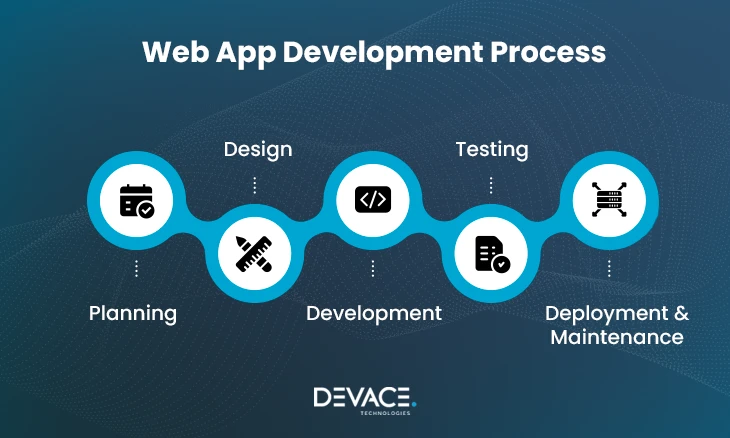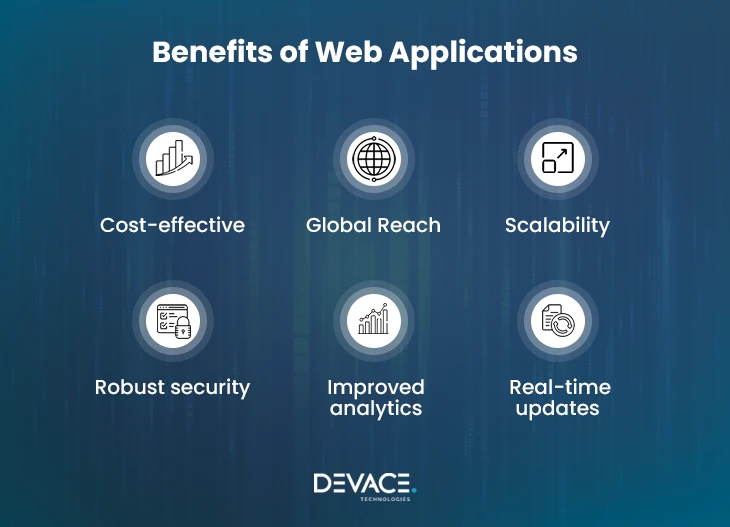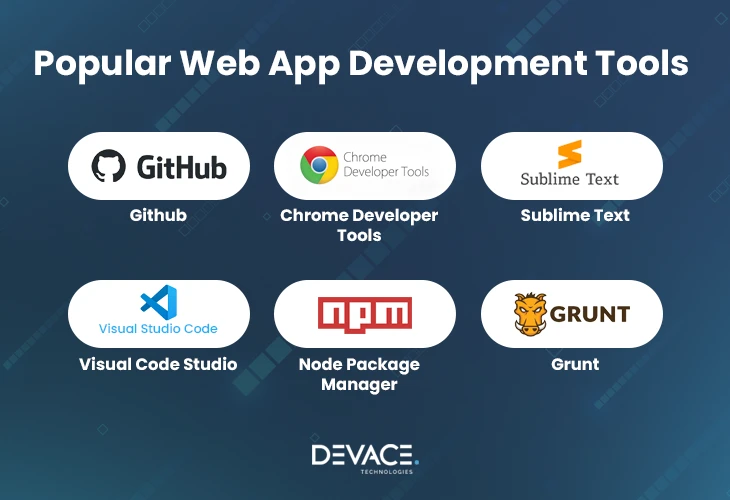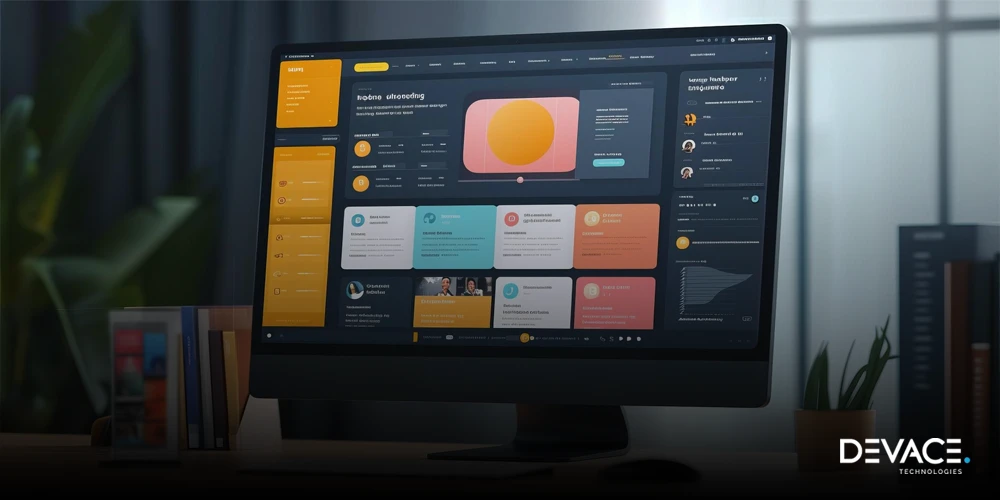Web app development is your chance to digitize your business, bringing your products or services to the fingertips of the masses. Indeed, without a web app, your survival in this competitive market is unlikely.
We know that you might have started thinking about the cost and declined the idea of building one. But stop! Let us tell you that web application development is not as costly or difficult as you think. After reading this blog you will agree because we are going to tell you all about web development, its cost & technologies used.
So, without further ado! Let’s get started with the introduction of web apps.
What is Web Application Development?
Web application development is the process of developing application programs accessible through web browsers. These applications offer functionalities and services from complex web pages to simple interactive platforms.
However, the process of development consists of several steps starting with elaborating the app’s purpose or goals.
Process Of Web Application Development
The procedure for website app development can be simple as well as complex depending on the features and functionalities. Generally, the common industrial practice or procedure is given below:

Step 1: Planning
It is the most important step in this process where the team collects all the relevant details about the project. Here, the following things are decided before proceeding any further.
- Project goals and objectives.
- Target audience and business requirements.
- Architecture of an app (MVC, microservices, etc.).
- Technology stack and web application framework.
- Functional and non-functional requirements.
Step 2: Design
The second step in this process of web application development is design.
All requirements collected in the first step are to the designer. The designers then visualize the project’s vision by creating the web or mobile app’s initial design.
The following points are covered in this stage:
- Create a user interface (UI) and the user experience (UX) of the web app.
- The prototype and mockups are designed to visualize the interactions.
- The whole user journey is decided.
In this phase, constant communication with clients is necessary once the design is finalized from their end. The developers take on the charge and hence the development process begins.
Hire top web developers to create a dynamic and feature-rich website
Stage 3: Development
After the finalization of the design, the back and the front end of the web app are developed. The front end is all about the client side whereas the back end is concerned with the overall functionality of the app like determining and creating databases, APIs, etc. The web development involves tasks like:
- Ensuring the web app can operate on both iOS & Android.
- Determining the optimization metrics.
- Developing an interactive user interface.
You cannot deploy the app immediately after the development. Therefore, what you need to do is to check it for bugs and other shortcomings
Step 4: Testing
The next step in the web app development process is testing. In this stage, the dedicated quality assurance team performs various types of tests:
Functionality testing
- Checking the cross-browser compatibility.
- Ensuring seamless functioning of interactive elements.
Performance testing
- Assessing page loading times.
- Evaluating responsiveness across different devices.
- Stress testing (checking web app under high traffic conditions).
Security testing
- Checking web apps for bugs and vulnerabilities.
- Verification of authentication mechanisms.
Step 5. Deployment & Maintenance
After the testing phase, the web app is deployed across multiple platforms and made available to the public. But deployment in the web application development process is not the end. Immediately, after the deployment the process of maintenance starts in which the new updates and features are added.
The web app development process remains the same. But based on the varied needs of each company web development is categorized into different types.
Types of Web Application Development
Web app development can be divided into different types depending on the needs of the business. Let’s have a look at them!
Front End Web Development
It is all about the development of a website’s user interface or application using frontend technologies and frameworks such as:
- HTML
- CSS
- JavaScript
Front-end web development refers to the planning and execution of how images, text, and colors will appear. It focuses on the overall look and feel of the website.
Back End Web Development
Backend development refers to server-side development. Also includes the application of the best backend frameworks and technologies to create code logic, servers, architecture, and APIs.
Full Stack Web Development
Full stack web development is building and programming both front and back-end. It is also called the end-to-end development of digital applications. The full stack developers use different web development stacks to develop web apps.
Many companies out there offer businesses to hire backend developers or full-stack developers as per their needs. Other than this, if you want to just improve your user interface then it is good to hire front-end developers.
Moreover, depending upon your project’s needs you should decide the type of web app development. Let’s see the importance of the web app as well as the importance of choosing the right web application development process.
Importance of Web App Development
Web app development is a complex but crucial process for businesses worldwide. Therefore, the selection of the right development partner determines the future of your app.
However, considering the potential of web apps there are many big names out there who have equipped themselves with web apps. To tap into a huge market of generation that is always on the go. Some of the famous brands with fantastic web apps are:
- Starbucks
- Ali baba
- Forbes
Web apps are your great chance to tap into the market of potential buyers because smartphones constitute 70% of global retail website visits. You can tap into this massive market and reap the benefits of the web application development process.
Benefits of Web Application Development
Web application development holds a key to success for businesses, giving them a chance to access many buyers. The other benefits are given below:
- Offer businesses the chance to excel by offering new services & products.
- Web apps automate processes reducing manual efforts & improving efficiency.
- Access to large quantities of customer or visitor data.
- Less maintenance and development costs.

To lay the robust foundation of your app you need a strong backend and frontend which depends upon the language or framework you choose.
Equip your web app with the latest tools & technologies to fuel your success.
Programming Languages Used in Web App Development
There are tons of programming languages out there but below are the top ones that can benefit you in the website application development process.
JavaScript
JavaScript is popular for efficient and scalable web development.
- JavaScript is exceptional for front-end development as it powers interactive web interfaces.
- It can be used for backend development with Node.js.
HTML
HTML is a Hyper Text Markup Language for designing and creating web pages. Some of the qualities of HTML are:
- Best for defining and structuring the layout of elements.
- Provides a foundation for displaying text, images forms, etc.
Now, HTML5 has new capabilities such as audio/video playback and canvas for drawing graphics directly on web pages.
Python
Python is an open-source, scalable, and powerful programming language. It often fuels the backend in web application development.
- Python’s frameworks like Django and Flask are used for backend development.
- Its simplicity and readability are best for building robust and scalable apps.
This language is also quite effective for full-stack development fueling both front-end and back-end (using libraries like React or Django etc.). It is because of its high utility that big names are looking to hire Python developers.
CSS (Cascading Style Sheets)
It is a style sheet to add styles to Web documents such as font, color, and spacing.
- It explains the document presentation written in markup language (XML or HTML).
- The cascading nature gives control over the design of web pages.
Golang
Golang is a scalable, simple, and fast language which is known for its performance and efficiency.
- Best for developing scalable back-end systems and APIs.
- It supports concurrency through goroutines and channels.
This language is highly focused on fast compilation times and easy maintenance making it the perfect choice for web app development.
TypeScript
TypeScript is a free and open-source programming language and superset of Java.
- TypeScript is used with front-end frameworks like Angular to improve code quality.
- It is used in front-end development.
Ruby
Ruby is an object-oriented open-source programming language that focuses on productivity.
- Ruby has rich collection frameworks and libraries.
- It has an elegant syntax making it easy to read and write.
Now you know the top programming languages for web app development it’s time that you know the frameworks also. So that when you hire web developers you know the basics to lead them to success.
Web Application Development Frameworks
The frameworks are essential in laying the robust foundation of web apps. However, you must select the web development framework that makes the development process efficient and smooth.
Django (Python)
Django is a high-level open-source Python framework known for its simplicity. It has dynamic built-in features like authentication, an admin interface, and much more.
- Django follows the Model-View-Controller (MVC) architectural pattern.
- It supports efficient web app development.
Other than this, Bottle, Flask, and Fast API are also among the top 15 Python frameworks that are essentially useful for web application development.
Express Js
It is a Node.js framework that gives various features for web app development and networking services.
- It supports minimalism for developing server-side applications & APIs.
- Best for the creation of lightweight apps.
Ruby on Rails (RoR)
It is a robust developer-friendly framework that is known for its elegant syntax. RoR believes in the convention over configuration.
- It focuses on code reusability and maintainability.
- Ruby on Rails (RoR) is best for quick prototyping.
RoR reduces redundancy and this is one of the main reasons Ruby on Rail experts are in demand.
ASP.NET (C#)
This is a framework for web app development by Microsoft. It is an open-source framework useful for creating modern mobile apps.
- It has tools, components, and libraries for building apps.
- ASP.NET with MVC architecture gives a structured approach to web application development.
Laravel
Laravel is a PHP framework that focuses on ease of use. It is an elegant framework, with features like authentication, etc.
- This framework is efficient for database migrations, seeding & developing custom commands.
- Offers a set of commands for effectively managing Laravel applications.
Due to these and more features companies hire Laravel developers regardless of niche and industry.
Web App Development Tools
There are various web development tools available in the market that can help web developers in the creation of bulletproof apps.

Web apps are going to stay and thereby stand part in the competition. You must know trends that can make your app dynamic.
Future of Web Application Development
If you are aware of the trends given below, then nothing can stop your app from reaching the heights of success.
Accelerated Mobile Pages (AMP)
The first trend that is going to rule the web application development world is Accelerated Mobile Pages (AMP). It is an open-source project that aims to make the mobile app efficient by offering a framework that loads fast.
GitHub Copilot
Another exciting trend to keep an eye on is the GitHub Copilot which is a powerful tool to leverage the power of AI. It suggests complete code in real-time based on the programming language and context. GitHub Copilot guarantees improving code accuracy and efficient programming.
Artificial Intelligence
Of course, AI is going to play a major role in the future of web app development. This technology will be great in providing a more personalized experience for the users.
Serverless Architecture
The serverless architecture solving challenges like system overloading and bottlenecks is also part of the trend. It operates on cloud technology and allows users to write and execute code for any type of web application.
Progressive Web Apps (PWAs)
Progressive Web Apps (PWAs) because of their efficiency, accessibility, and ability to work offline will be trending this year too. It offers a faster time to market because of a single code base.
We have also jotted down web app development cost estimation just for you. However, the cost can increase or decrease depending on the complexity of your project.
Cost of Web App Development
Here is the cost estimation of web apps that can help you decide what is best for your business as per your budget.
| Type | Functionality | Cost |
|---|---|---|
| Simple |
|
$5000-$20,000 |
| Medium |
|
$25,000-$65,000 |
| Complex |
|
$70,000-$250,000 |
Wrapping Up
Web app development is the process of creating an app that fulfills the needs of the businesses as well as its users. But this process is complex, and you need to fully understand it even if you are looking to hire a web app development company. Or you are thinking of developing it on your own.
Need Web App Developers for Your Business! Hire Devace
If you are looking to hire developers, then Devace is at your service. Our expert web app developers can take care of every detail!
- 24/7 availability
- Time Zone aligned
- Flexible hiring models
- Market-friendly pricing
- 14 days trial period
- Swift hiring (Staffing within 48 hours)
Get in touch here 📞
Frequently Asked Question
What is the best technology for building web applications?
There is no simple answer to this, however, you can decide the best technology based on your project requirements. Right now, the commonly used technologies include frameworks of Java such as React.js or Angular for frontend development. For backend development Node.js or Python frameworks like Flask and Django are perfect.
Which software is mostly used for web development?
Web development is a detailed process, and the commonly used software is given below:
- WordPress
- Drupal
- Joomla
- Wix
- Adobe Dreamweaver
- Weebly
- Sublime Text
- Chrome Developer Tools
The frameworks that are commonly used are jQuery, Django, and Laravel.
What are the names of some skills needed to create web apps?
The development of web apps requires skills in programming languages such as HTML and CSS. JavaScript for frontend and Python, Ruby, and Node.js for backend including frameworks like Django & React, are essential for creating scalable web apps.
Additionally, the know-how of databases and version control systems is a plus.


